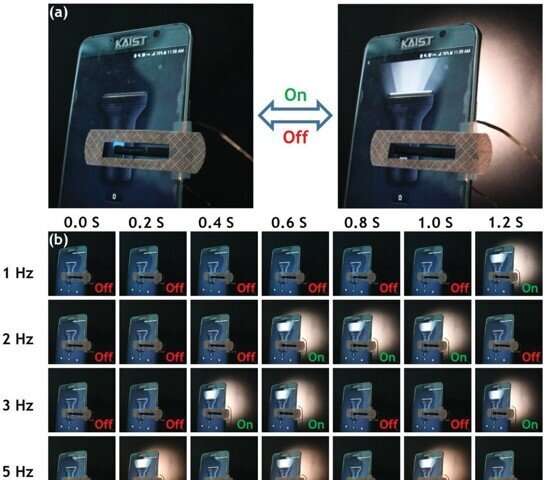Artificial soft-touch fingers: A new class of low-voltage smart device

Soft actuators are an exciting class of smart devices that are actuated by an external stimulus such as light, temperature, electric potential or pneumatic pressure. Softness is one of the main advantages of these actuators. For example, hard, sharp materials can potentially damage a touchscreen panel; however, soft actuators can operate without damaging touch panels, and they produce negligible vibrations. Thus, novel devices such as artificial soft-touch fingers can be realized using these actuators.
Ionic polymer soft actuators (IPSA)
Among soft actuators, ionic polymer soft actuators (IPSA) use electric potential as the stimulus. Typically, an electroactive polymer film (containing positive and negative ions) is sandwiched between two flexible electrodes. The size of positive and negative ions is different. When an electric potential is applied at the electrodes, the positive and negative ions move toward oppositely charged electrodes. Due to the size difference, one side of the polymer film swells up while the other contracts, thereby producing bending deformation. This bending deformation is similar to the motion that we perform when we use our fingers.
The use of electric potential as the stimulus makes the IPSA a strong candidate for robotic applications. However, practical applications demand the IPSA to display a large bending deformation at low input voltages and high frequencies (fast motion).
From the structure of the IPSA, it can be inferred that these actuators are, indeed, capacitors. In order to achieve a large bending deformation at low input voltages and high frequencies, a high charge storage capacity and a high charge transfer are required. However, these properties are antagonistic and impossible to find simultaneously in a single type of material.
How to solve the problem
In recent years, nanocomposites have been employed in various applications to resolve the trade-offs and impart antagonistic properties. The hybrid structures offer ease of design according to the specific application. For the said problem, we, at the Active Materials Lab (Korea Advanced Institute of Science and Technology (KAIST)), came up with the idea of using a combination of molybdenum disulfide (MoS2) and reduced graphene oxide (rGO). MoS2 is known to possess high charge storage capacities and has been extensively investigated in the field of supercapacitors. On the other hand, rGO is an excellent conductor, providing a high-charge electron transfer. When combined, MoS2 and rGO complement each other in charge storage (by the formation of nano P-N junctions) and charge transfer (by providing additional paths for charge flow). Thus, the nanocomposite is capable of providing high charge storage and charge transfer simultaneously.
Artificial soft-touch fingers
IPSA using this novel nanocomposite displayed high bending deformations (~10 mm) along with fast responses (~ 8 Hz) at very low voltages (0.1-1.5 V). These unique features enabled us to develop artificial soft-touch fingers.
A conceptual design for this device has been presented. It is evident from the video that the soft finger (black-colored moving strip at the center of the patch on the smartphone) was able to switch between the on/off flashlight states of the smartphone at a rapid pace. Similarly, the finger was connected to a moving stage and accomplished the touching function at certain positions on the tablet surface (see the figure).
In the future, this soft finger can perform more complex tasks if it is connected with a control circuit with more states of frequencies and voltage amplitudes, or even artificial intelligence control systems. Moreover, the fingers work on a very low voltage (0.1 V) and can, therefore, be directly attached to the nervous system and later controlled by the brain. Hence, they can be used to help people who have lost their fingers or were born with missing fingers.
In summary, the "artificial soft-touch fingers" concept presents an exciting new class of smart devices that should be explored more in the coming years.
This story is part of Science X Dialog, where researchers can report findings from their published research articles. Visit this page for information about ScienceX Dialog and how to participate.
More information:
Muhammad Taha Manzoor et al. Mutually Exclusive p‐Type and n‐Type Hybrid Electrode of MoS 2 and Graphene for Artificial Soft Touch Fingers, Advanced Functional Materials (2019). DOI: 10.1002/adfm.201905454
Bio:
Mr. Taha recently completed his MS from Korea Advanced Institute of Science and Technology (KAIST). There he worked under the supervision of Prof. Ilkwon Oh in ACTIVE Materials Lab on the topic of soft actuators. Currently, he is pursuing a Ph.D. degree in Mechanical Engineering from McGill University, Montreal.